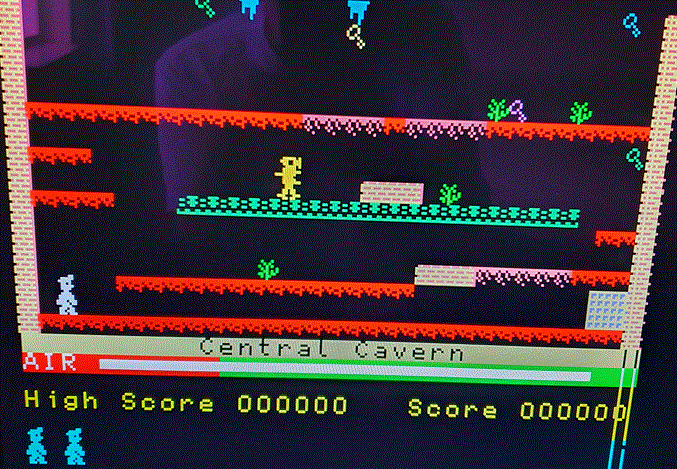After a little while, I got the Manic Miner fully working, including sound:

But in the video signal, there are two annoying stripes at the right side of the screen (also going through the score). This is related to a end-of-line flag that is tested there in the microcode that builds the screen. The exact reason is not known yet. [ edit: the reason was found, and the bug removed.]
SOUND
The sound took a little fiddling to get it to work properly. The ZX Spectrum has a very simple sound system, similar to that of the Apple II. It is a single bit of an output port (port 0xFE), that is amplified with a single transistor, and connected to a small speaker. The program has loops that toggle that bit with a certain timing.
The Z80 of the Spectrum runs at 3.5 MHz. Isetta runs at 12.5 MHz. But Isetta spends around 73% of her time rendering the Spectrum screen, so her effective speed is about 3.375 MHz. A Spectrum program, generating a constant tone, would come out as a series of high-frequency 'chirps' during blanking time.
The write to the 0xFE output port is handled by microcode. It now stores the value instead of writing it to the speaker. At every line interrupt, this value is put in a buffer (only during blanking time when the Z80 code runs, that is about 140 lines per frame ). But in every line interrupt (525 times per frame), a value is read from the buffer and written to the sound output. The same value is used four times, and then the buffer pointer is incremented. So the sound is stretched by a factor 4.
It had another problem. The sound bit is normally zero, then it toggles during the tone, and then is zero again. This means that it has a low-frequency component. In the ZX with its tiny speaker this was probably no problem, but in my case I have a set of amplified PC-speakers (with 3.5 mm jack connector) that have a 'good' bass response. So the little 'music' tones were accompanied by loud plop sounds.
The sound system of Isetta has 8-bit samples. I defined a level that was halfway the 0 and 1 of the speaker signal. So normally the signal was at 50%. When port 0xFE was written, the signal would be 0% or 100 %. But the point is, it is difficult to know when the tone stops, so you don't know when to go back to 50% . I did this as follows. At each interrupt, when the 0xEF port was not written, I bring the speaker signal a few steps closer to 50%. So when the tone stops, the signal will go to 50% quite soon. This gave a reasonable sound quality.
KEYBOARD
I already had Z80 code to convert the PS/2 keyboard to ASCII, and to convert ASCII to the codes for the ZX Spectrum keyboard matrix. But for playing a game, I also had to use the PS/2 'key released' messages, to tell the game program exactly when a key was released.
THE GREAT ESCAPE
I tried another program. The Great Escape. This program also has a very good, commented disassembly.
In this program, a prisoner of war has to escape from a prisoners camp. It is totally different from the previous game.

The display is a semi-3D rendering. It is almost a modern game, where a camera follows the hero on the terrain and in the several buildings.
It did not take much time before I saw the first guards walking on the screen. But it was only a few second, then the program crashed. What could it be ? I looked through the source and I found it used an instruction that I had not implemented, because my thought had been, who is ever going to use that ?? RRD Rotate Right Digit
But the game uses it to shift the whole screen four pixels to the left or the right....
So the RRD and RLD are now also in the microcode.
Program worked. But I have no clue how to escape...
Discussions
Become a Hackaday.io Member
Create an account to leave a comment. Already have an account? Log In.